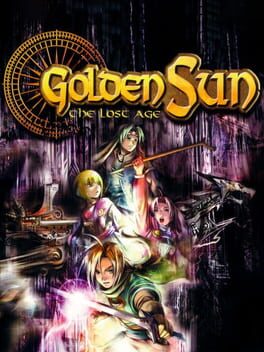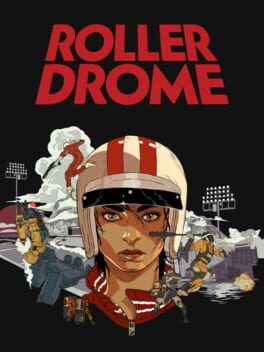RayneSol
Bio
From Mario to Bloodborne and everything in between, the backlog ever grows but the journeys never end. Nintendo | PlayStation | PC
From Mario to Bloodborne and everything in between, the backlog ever grows but the journeys never end. Nintendo | PlayStation | PC
Badges

1 Years of Service
Being part of the Backloggd community for 1 year

GOTY '22
Participated in the 2022 Game of the Year Event

N00b
Played 100+ games

Roadtrip
Voted for at least 3 features on the roadmap

Popular
Gained 15+ followers

Best Friends
Become mutual friends with at least 3 others

Noticed
Gained 3+ followers
Favorite Games
154
Total Games Played
004
Played in 2024
021
Games Backloggd
Recently Played See More
Recently Reviewed See More
Marvel's Spider-Man | Game Review
Developed by Insomniac Games
Published by Sony Interactive Entertainment
Released 2018 on PS4 & PS4 Pro
[Played on PS4 (2018)][100% Completion, approx 40 hrs][Spectacular Difficulty]
Debuted at Sony's stellar 2016 E3 showcase, Marvel's Spider-Man exclusive to the PS4, set itself up to be the greatest game yet for the Marvel mascot. Longtime PlayStation partner Insomniac Games (Ratchet & Clank, Resistance, Sunset Overdrive) has delivered on crafting one of the best super-hero games to date but not without some flaws.
This isn't the traditional Peter Parker origin story fans are used to. The game tells a story of a 23 year old Peter. A college graduate and apprentice at a nondescript robotics lab in lower-east Manhattan, Peter has a habit of showing up to work late for obvious reasons. At this point he's already put away many bigger villains than two-bit thugs.
The plot involves Insomniac's assembly of the Sinister Six and working around established relationships with familiar characters as well as new ones. Discovering the motivations behind central villain Mr. Negative while figuring out how to reconcile a serious relationship with Mary Jane Watson is just some of the struggles both Spider-Man and Peter Parker have to deal with throughout the game.
The game's story is a comic come to life. Quips are in full force but even the narrative can reach real emotional beats than just sticking to humour and heroics. There isn't a lot to environmental story-telling. The narrative is told through cinematic cut-scenes with occasional sections where the player looks at items while Spider-Man comments about them in a way to provide extended lore of the story and characters at play. Even still the narrative does not stretch too far beyond the familiar bounds of a traditional super-hero story. Yet it's still interesting enough to never feel disappointing or questionable.
Insomniac's Spider-Man is trailed with many comparisons to Rocksteady's 'Batman: Arkham' game series for many reasons other than being a Super-hero game but for also having combat that involves dealing with multiple enemies and stealth sections where Spidey quietly takes unsuspecting enemies out one-by-one.
Despite this Spider-Man still manages to play and feel unique all on it's own. It's refreshing that Spidey can dash from one enemy to the other within his superhuman context instead of breaking logic to fit within the specifications of video game design (like Batman sometimes does in the Arkham games).
What separates Spider-Man's combat is the air combat. By holding the Square button when attacking, Spider-Man will launch the enemy into the air. The player can then chain attacks and alternate with leaping off enemies and shooting webs to incapacitate enemies. Hoping from one enemy to the other ends up feeling natural as the player gets used to how to play. Spider-Man can shoot a web at an enemy and propel himself towards them at the push of a button, a nice way to close the gap.
Web Gadgets can be used for alternative ways of dealing with foes like the Web Bomb which can be used to handle large groups by detonating and captures any enemy in the blast radius. The learning curve isn't too steep but mastering the agile combat system and using everything to it's fullest-the experience can feel exhilarating.
Side activities are present in the city to compliment the main story progression. Puzzle solving is also present as sort of mini-games that Peter does in the lab when he's out of the suit. Each activity has the benefit of extra experience points and what is known as Research Tokens. There are a variety of Tokens in the game used for upgrading gadgets, buying suits, and learning new abilities. Tokens are obtained a variety of ways besides puzzles. Finding backpacks for example will net you "Backpack Tokens". Unfortunately the game makes it a little too easy as every icon is shown on the map when you unlock parts of Manhattan through police towers. Pinpointing collectible backpacks become the minimal work of following a way-point but only if you choose.
Other map activities include taking pictures of Landmarks, stopping random crimes in the street and even chasing pigeons. Side activities didn't prove to be very impressive and only felt like micro tasks to fill in an open world with something to do while you swing from one point to another.
One side activity that does shine a bit are the street activities because of the way they take place in the game's world. Chasing a car and apprehending the reckless drivers feels fast as the car is driving through traffic. This makes events in the open world feel seamless in the environment. But after a certain amount of hours when there's no new tricks left it can become repetitive and feel like another checklist activity.
Insomniac has provided players with beautiful visuals within the playground of Manhattan. Character detail on the star himself are uncanny in their realism. Textures like the cloth of Spidey's new Advanced Suit sports a nice sheen under light.
The game showcases enough lighting and definition to make Manhattan feel real. Atop the highest skyscraper you can gloss over the neighbouring boroughs with an astonishing view. Swinging up high and catching the lens flare as the sun sets or swinging through the light-illuminated Times Square at night helps keep variation to the static setting.
What's more, wall crawling feels lively as windows are not just drawn closed but can be seen through. Looking at a bedroom or laundry room instead of just a reflection add to making the city feel alive even if they're just flat rendered images.
The animation work is smooth and fluid. Swinging from point to point looks as natural as if the character were real. Insomniac's fantastic motion blur effect blends multiple animations together. But of course it's not perfect as sometimes a player's input while swinging in different directions can result in an animation that doesn't look like it fits well with the game's physics. Like launching a web shot in one direction but immediately turning the character in another direction. Regardless the rest of the game flows so well one wouldn't mind the rare mishap.
Netflix's Daredevil composer John Paesano provides the score here with an excellent opening theme. The music also swells while swinging through the city as the orchestral sounds compliment the web swinging action.
The audio design is quite infectious: shooting a web is distinct and knocking enemies out sounds as powerful as it feels. The voice acting is well-performed and add to the enjoyment of the cinematic moments. Peter's voice actor Yuri Lowenthal even recorded two sets of lines: one in a calm, normal manner and the other set with more exertion whenever Spidey is talking and swinging or fighting at the same time.
The user-interface is fairly dynamic, fading certain aspects in and out depending on the situation. The game menu displays a map of Manhattan littered with icons of collectibles and challenges. Other menus include Suits and suit related abilities, general abilities, gadgets, missions, benchmarks, character info and a move list.
Game settings are not comprehensive but still give a good amount of options for visual and audio. Difficulty can be changed at any time while motion blur and other film effects can be turned off or lowered. The most detailed portion of the game settings however is the Accessibility options. There are many ways to tailor the game experience for anyone but especially players with disabilities. Puzzles can be skipped, the HUD can be adjusted, and quick-time events can be set to auto complete.
During my play-through I did encounter a few bugs: at the end of a car chase when stopping a runaway vehicle on a declined road, the car stayed afloat in mid-air. The remaining enemies disappeared and the crime was unable to complete. Another incident involved swinging into a building that was not intended to be entered. From the inside you could see through the walls, and even go into the smaller shops at the base of the building. There was no way to exit which forced me to reset the game. Although this is extremely rare and does not persist throughout the game.
Swinging from point-to-point, fighting, chasing drones, cars and webbing bad guys is the core of the game. What Insomniac tries to do to help vary this core throughout the story is let us play as other characters. These characters aren't Peter so of course, in these moments - the pace can definitely feel bogged down by stealth missions.
The game design in these areas are minimal with basic stealth mechanics and objectively simple AI. The game tries somewhat to build upon these sections but by the end of the game the final stealth chapters don't feel like they've made any real progression in increasing the difficulty and mechanics.
The game is also limited on consistent boss fights. At times the game can feel like it holds your hand a little too much. It's quick to point out the next location to progress or highlight an object that needs to be interacted with.
The level design can also feel uninspired as internal areas are extremely linear with no real intention of challenging the player beyond simply moving from one area to another. This is what ultimately ends up being the biggest drawback instead of a minor nitpick. It would have been great to see Spider-Man's abilities used more in the game design beyond traversal and combat.
Enough can't be said for how fun it is to just swing through the city. For as simple as it is to swing there are ways to enhance traversal from building to building. Bursts of a web shot over roof tops help with keeping momentum. Swinging to a point and launching off followed by diving into the street and snapping into a swing fueled by inertia is just cathartic.
Marvel's Spider-Man might not be the best game of 2018 from a critical stand point but it is absolutely the most fun. If a single game mechanic like Web Swinging can have you joyously playing for hours without making any kind of real progression then that is a good enough reason to play it. But in this case with the addition of excellent cinematic presentation, fluid combat and fun traversal, Insomniac's Spider-Man is an amazing time.
9 /10 - AMAZING
Wonderful visuals, tight controls, and sensational web-swinging make Marvel's Spider-Man an amazing ride.
Originally published at http://gameskyraynesol.wordpress.com on October 9, 2018.
Developed by Insomniac Games
Published by Sony Interactive Entertainment
Released 2018 on PS4 & PS4 Pro
[Played on PS4 (2018)][100% Completion, approx 40 hrs][Spectacular Difficulty]
Debuted at Sony's stellar 2016 E3 showcase, Marvel's Spider-Man exclusive to the PS4, set itself up to be the greatest game yet for the Marvel mascot. Longtime PlayStation partner Insomniac Games (Ratchet & Clank, Resistance, Sunset Overdrive) has delivered on crafting one of the best super-hero games to date but not without some flaws.
This isn't the traditional Peter Parker origin story fans are used to. The game tells a story of a 23 year old Peter. A college graduate and apprentice at a nondescript robotics lab in lower-east Manhattan, Peter has a habit of showing up to work late for obvious reasons. At this point he's already put away many bigger villains than two-bit thugs.
The plot involves Insomniac's assembly of the Sinister Six and working around established relationships with familiar characters as well as new ones. Discovering the motivations behind central villain Mr. Negative while figuring out how to reconcile a serious relationship with Mary Jane Watson is just some of the struggles both Spider-Man and Peter Parker have to deal with throughout the game.
The game's story is a comic come to life. Quips are in full force but even the narrative can reach real emotional beats than just sticking to humour and heroics. There isn't a lot to environmental story-telling. The narrative is told through cinematic cut-scenes with occasional sections where the player looks at items while Spider-Man comments about them in a way to provide extended lore of the story and characters at play. Even still the narrative does not stretch too far beyond the familiar bounds of a traditional super-hero story. Yet it's still interesting enough to never feel disappointing or questionable.
Insomniac's Spider-Man is trailed with many comparisons to Rocksteady's 'Batman: Arkham' game series for many reasons other than being a Super-hero game but for also having combat that involves dealing with multiple enemies and stealth sections where Spidey quietly takes unsuspecting enemies out one-by-one.
Despite this Spider-Man still manages to play and feel unique all on it's own. It's refreshing that Spidey can dash from one enemy to the other within his superhuman context instead of breaking logic to fit within the specifications of video game design (like Batman sometimes does in the Arkham games).
What separates Spider-Man's combat is the air combat. By holding the Square button when attacking, Spider-Man will launch the enemy into the air. The player can then chain attacks and alternate with leaping off enemies and shooting webs to incapacitate enemies. Hoping from one enemy to the other ends up feeling natural as the player gets used to how to play. Spider-Man can shoot a web at an enemy and propel himself towards them at the push of a button, a nice way to close the gap.
Web Gadgets can be used for alternative ways of dealing with foes like the Web Bomb which can be used to handle large groups by detonating and captures any enemy in the blast radius. The learning curve isn't too steep but mastering the agile combat system and using everything to it's fullest-the experience can feel exhilarating.
Side activities are present in the city to compliment the main story progression. Puzzle solving is also present as sort of mini-games that Peter does in the lab when he's out of the suit. Each activity has the benefit of extra experience points and what is known as Research Tokens. There are a variety of Tokens in the game used for upgrading gadgets, buying suits, and learning new abilities. Tokens are obtained a variety of ways besides puzzles. Finding backpacks for example will net you "Backpack Tokens". Unfortunately the game makes it a little too easy as every icon is shown on the map when you unlock parts of Manhattan through police towers. Pinpointing collectible backpacks become the minimal work of following a way-point but only if you choose.
Other map activities include taking pictures of Landmarks, stopping random crimes in the street and even chasing pigeons. Side activities didn't prove to be very impressive and only felt like micro tasks to fill in an open world with something to do while you swing from one point to another.
One side activity that does shine a bit are the street activities because of the way they take place in the game's world. Chasing a car and apprehending the reckless drivers feels fast as the car is driving through traffic. This makes events in the open world feel seamless in the environment. But after a certain amount of hours when there's no new tricks left it can become repetitive and feel like another checklist activity.
Insomniac has provided players with beautiful visuals within the playground of Manhattan. Character detail on the star himself are uncanny in their realism. Textures like the cloth of Spidey's new Advanced Suit sports a nice sheen under light.
The game showcases enough lighting and definition to make Manhattan feel real. Atop the highest skyscraper you can gloss over the neighbouring boroughs with an astonishing view. Swinging up high and catching the lens flare as the sun sets or swinging through the light-illuminated Times Square at night helps keep variation to the static setting.
What's more, wall crawling feels lively as windows are not just drawn closed but can be seen through. Looking at a bedroom or laundry room instead of just a reflection add to making the city feel alive even if they're just flat rendered images.
The animation work is smooth and fluid. Swinging from point to point looks as natural as if the character were real. Insomniac's fantastic motion blur effect blends multiple animations together. But of course it's not perfect as sometimes a player's input while swinging in different directions can result in an animation that doesn't look like it fits well with the game's physics. Like launching a web shot in one direction but immediately turning the character in another direction. Regardless the rest of the game flows so well one wouldn't mind the rare mishap.
Netflix's Daredevil composer John Paesano provides the score here with an excellent opening theme. The music also swells while swinging through the city as the orchestral sounds compliment the web swinging action.
The audio design is quite infectious: shooting a web is distinct and knocking enemies out sounds as powerful as it feels. The voice acting is well-performed and add to the enjoyment of the cinematic moments. Peter's voice actor Yuri Lowenthal even recorded two sets of lines: one in a calm, normal manner and the other set with more exertion whenever Spidey is talking and swinging or fighting at the same time.
The user-interface is fairly dynamic, fading certain aspects in and out depending on the situation. The game menu displays a map of Manhattan littered with icons of collectibles and challenges. Other menus include Suits and suit related abilities, general abilities, gadgets, missions, benchmarks, character info and a move list.
Game settings are not comprehensive but still give a good amount of options for visual and audio. Difficulty can be changed at any time while motion blur and other film effects can be turned off or lowered. The most detailed portion of the game settings however is the Accessibility options. There are many ways to tailor the game experience for anyone but especially players with disabilities. Puzzles can be skipped, the HUD can be adjusted, and quick-time events can be set to auto complete.
During my play-through I did encounter a few bugs: at the end of a car chase when stopping a runaway vehicle on a declined road, the car stayed afloat in mid-air. The remaining enemies disappeared and the crime was unable to complete. Another incident involved swinging into a building that was not intended to be entered. From the inside you could see through the walls, and even go into the smaller shops at the base of the building. There was no way to exit which forced me to reset the game. Although this is extremely rare and does not persist throughout the game.
Swinging from point-to-point, fighting, chasing drones, cars and webbing bad guys is the core of the game. What Insomniac tries to do to help vary this core throughout the story is let us play as other characters. These characters aren't Peter so of course, in these moments - the pace can definitely feel bogged down by stealth missions.
The game design in these areas are minimal with basic stealth mechanics and objectively simple AI. The game tries somewhat to build upon these sections but by the end of the game the final stealth chapters don't feel like they've made any real progression in increasing the difficulty and mechanics.
The game is also limited on consistent boss fights. At times the game can feel like it holds your hand a little too much. It's quick to point out the next location to progress or highlight an object that needs to be interacted with.
The level design can also feel uninspired as internal areas are extremely linear with no real intention of challenging the player beyond simply moving from one area to another. This is what ultimately ends up being the biggest drawback instead of a minor nitpick. It would have been great to see Spider-Man's abilities used more in the game design beyond traversal and combat.
Enough can't be said for how fun it is to just swing through the city. For as simple as it is to swing there are ways to enhance traversal from building to building. Bursts of a web shot over roof tops help with keeping momentum. Swinging to a point and launching off followed by diving into the street and snapping into a swing fueled by inertia is just cathartic.
Marvel's Spider-Man might not be the best game of 2018 from a critical stand point but it is absolutely the most fun. If a single game mechanic like Web Swinging can have you joyously playing for hours without making any kind of real progression then that is a good enough reason to play it. But in this case with the addition of excellent cinematic presentation, fluid combat and fun traversal, Insomniac's Spider-Man is an amazing time.
9 /10 - AMAZING
Wonderful visuals, tight controls, and sensational web-swinging make Marvel's Spider-Man an amazing ride.
Originally published at http://gameskyraynesol.wordpress.com on October 9, 2018.
Super Mario RPG: Legend of the Seven Stars
Quick Review
8.5 - EXCELLENT | Played: 2021 | Playtime: ~25hrs
+ Timed Command Actions not over-done
+ Comedic beats in a light hearted story
+ Square's original characters are fun with interesting designs
+ Game length isn't too long - well paced
+ Difficulty feels mostly balanced without the need for much grinding
/ A handful of dispersed mini-games where some can be fun- others not so much
/ Character designs are nice but environments feel lackluster even for it's time
- Fixed isometric camera leads to frustrating platforming
- Weapon and armour selection is linear
- One hit kill moves will always suck (ESPECIALLY in boss fights)
Quick Review
8.5 - EXCELLENT | Played: 2021 | Playtime: ~25hrs
+ Timed Command Actions not over-done
+ Comedic beats in a light hearted story
+ Square's original characters are fun with interesting designs
+ Game length isn't too long - well paced
+ Difficulty feels mostly balanced without the need for much grinding
/ A handful of dispersed mini-games where some can be fun- others not so much
/ Character designs are nice but environments feel lackluster even for it's time
- Fixed isometric camera leads to frustrating platforming
- Weapon and armour selection is linear
- One hit kill moves will always suck (ESPECIALLY in boss fights)
PS5 | Released: 2020 - Played: 2022 | Playtime: 7hrs | 100% Completion
A treat for longtime PlayStation fans and an excellent bundled game to start the new generation.
______________________________________________
If you’re lucky enough to get your hands on the coveted PS5 you may have gotten it for a number of games. But what comes pre-installed on the system is a nice little platformer in Astro’s Playroom, and makes for a great first foray into the new generation on PS5.
Last generation the PS4 came installed with “The Playroom”, bundled software featuring the “Astrobots” but which could only be played with the PlayStation camera. Astro’s Playroom on the other hand requires no other peripheral except for the DualSense controller. Astro’s Playroom is a game that can run the player anywhere from 4 - 6 hours or beyond depending on playstyle and makes for a fun Platinum trophy for those who want to go for 100%.
At its core the game is a 3D platformer, Astro can punch enemies, jump and instead of the typical double jump, can make some extra ground with propulsion jets which come out of it’s legs. You go through levels defeating enemies, hopping on platforms and weaving through obstacles. Although it sounds like the typical platformer fare, for a free game Astro’s Playroom does a number of things to not only take it beyond being a standard platformer, but beyond just a tech demo for a new console and controller.
The game’s central mechanical design revolves around the new DualSense controller. The metal surfaces of the game’s electronic environments let you feel each step Astro takes as well as hearing the metal clangs straight from the haptics themselves. The controller also does a decent enough job of simulating other surfaces like muddy terrain. Using weaponry like a bow and arrow also provides some tension when pulling the bow back.
The beginning of the game does act as a literal demo however, letting the player shake the controller to feel little bots bouncing around inside. Overall, every aspect of the DualSense is used: the haptics, triggers, touchpad and Gyro motion controls. All of these are combined in certain gameplay moments in each of the four levels. For example, the first I came across was Astro entering a robotic Frog suit. The controls are simple: tilt the controller left or right to tilt the suit and use the triggers like pulling back a spring to have the suit hop. Normally this type of control sounds unnecessary or cumbersome. But in each of the four level gimmicks using the DualSense features, the controls are surprisingly sound. They not only feel good but end up feeling natural. After a certain point you almost don’t notice how your hands are physically moving to meet the needs of each suit’s controls. Though this may be because each of these portions are well timed and short lived. Within each of the four main levels are four sequential areas. Two of the four areas in each level use the suits, and those portions of the levels are specifically designed for suit traversal and mechanics. It’s all cleverly used, but it can also feel like if the entire level were composed of the suit gameplay it would eventually feel annoying and cumbersome.
Astro’s Playroom lacks an overall narrative to the game. It essentially takes place inside of a PS5, which each level’s concept and design based on features of the system: a beach turned arctic area representing cooling, a race track representing the speed of the SSD and three other levels representing system memory, the fantastic singing GPU of the GPU Jungle and the CPU naturally being the core of the system serves as the main hub. In addition there’s a large Ethernet port shaped portal that takes the player to the Speedrun challenges: fun time trials in unique levels. But the fun of exploring each of the levels comes from finding the fantastic references to games that make up PlayStation’s history.
At the center of it all is “PlayStation Labo”. Not their own version of Nintendo’s cardboard peripherals, but a large room that you can fill with collectibles. Every hidden collectible is a well designed model of PlayStation hardware. From the PlayStation mouse to the 3D Pulse Headset, everything you unlock is placed here like a museum dedicated to the brand’s legacy. What’s best is as Astro you can run around the room and interact with other robots, find more fun Easter eggs, interact with a Vita to turn it on or open the PS2’s disc tray.
Where Astro’s Playroom falls short is not in it’s length but the enemies. The platforming does a good enough job of introducing concepts to navigate through even if they don’t last long but it’s not as fun to go through when each basic enemy can go down in one hit. As an act of balance, Astro itself will go down with one hit as well. It would’ve made for a more robust game if there were more enemy variety with different ways to take them down. As well as using combat items like the bow more often than the few times we’re allowed to use them. A lot of those issues stem from the game’s length, but as mentioned before, this isn’t a huge pitfall as this is a free, bundled game after all. For a full release it would be expected to see all the concepts here widely expanded upon.
In the end, Astro’s Playroom made for a lot of wholesome fun. The controls felt tight, good to play and the game is visually pleasing with adorable characters and levels full of charm. After Playroom, it’s safe to say Astrobot has secured itself as PlayStation’s best family-friendly mascot. New owners of a PS5 should not skip this little gift.
8.5 EXCELLENT
A treat for longtime PlayStation fans and an excellent bundled game to start the new generation.
______________________________________________
If you’re lucky enough to get your hands on the coveted PS5 you may have gotten it for a number of games. But what comes pre-installed on the system is a nice little platformer in Astro’s Playroom, and makes for a great first foray into the new generation on PS5.
Last generation the PS4 came installed with “The Playroom”, bundled software featuring the “Astrobots” but which could only be played with the PlayStation camera. Astro’s Playroom on the other hand requires no other peripheral except for the DualSense controller. Astro’s Playroom is a game that can run the player anywhere from 4 - 6 hours or beyond depending on playstyle and makes for a fun Platinum trophy for those who want to go for 100%.
At its core the game is a 3D platformer, Astro can punch enemies, jump and instead of the typical double jump, can make some extra ground with propulsion jets which come out of it’s legs. You go through levels defeating enemies, hopping on platforms and weaving through obstacles. Although it sounds like the typical platformer fare, for a free game Astro’s Playroom does a number of things to not only take it beyond being a standard platformer, but beyond just a tech demo for a new console and controller.
The game’s central mechanical design revolves around the new DualSense controller. The metal surfaces of the game’s electronic environments let you feel each step Astro takes as well as hearing the metal clangs straight from the haptics themselves. The controller also does a decent enough job of simulating other surfaces like muddy terrain. Using weaponry like a bow and arrow also provides some tension when pulling the bow back.
The beginning of the game does act as a literal demo however, letting the player shake the controller to feel little bots bouncing around inside. Overall, every aspect of the DualSense is used: the haptics, triggers, touchpad and Gyro motion controls. All of these are combined in certain gameplay moments in each of the four levels. For example, the first I came across was Astro entering a robotic Frog suit. The controls are simple: tilt the controller left or right to tilt the suit and use the triggers like pulling back a spring to have the suit hop. Normally this type of control sounds unnecessary or cumbersome. But in each of the four level gimmicks using the DualSense features, the controls are surprisingly sound. They not only feel good but end up feeling natural. After a certain point you almost don’t notice how your hands are physically moving to meet the needs of each suit’s controls. Though this may be because each of these portions are well timed and short lived. Within each of the four main levels are four sequential areas. Two of the four areas in each level use the suits, and those portions of the levels are specifically designed for suit traversal and mechanics. It’s all cleverly used, but it can also feel like if the entire level were composed of the suit gameplay it would eventually feel annoying and cumbersome.
Astro’s Playroom lacks an overall narrative to the game. It essentially takes place inside of a PS5, which each level’s concept and design based on features of the system: a beach turned arctic area representing cooling, a race track representing the speed of the SSD and three other levels representing system memory, the fantastic singing GPU of the GPU Jungle and the CPU naturally being the core of the system serves as the main hub. In addition there’s a large Ethernet port shaped portal that takes the player to the Speedrun challenges: fun time trials in unique levels. But the fun of exploring each of the levels comes from finding the fantastic references to games that make up PlayStation’s history.
At the center of it all is “PlayStation Labo”. Not their own version of Nintendo’s cardboard peripherals, but a large room that you can fill with collectibles. Every hidden collectible is a well designed model of PlayStation hardware. From the PlayStation mouse to the 3D Pulse Headset, everything you unlock is placed here like a museum dedicated to the brand’s legacy. What’s best is as Astro you can run around the room and interact with other robots, find more fun Easter eggs, interact with a Vita to turn it on or open the PS2’s disc tray.
Where Astro’s Playroom falls short is not in it’s length but the enemies. The platforming does a good enough job of introducing concepts to navigate through even if they don’t last long but it’s not as fun to go through when each basic enemy can go down in one hit. As an act of balance, Astro itself will go down with one hit as well. It would’ve made for a more robust game if there were more enemy variety with different ways to take them down. As well as using combat items like the bow more often than the few times we’re allowed to use them. A lot of those issues stem from the game’s length, but as mentioned before, this isn’t a huge pitfall as this is a free, bundled game after all. For a full release it would be expected to see all the concepts here widely expanded upon.
In the end, Astro’s Playroom made for a lot of wholesome fun. The controls felt tight, good to play and the game is visually pleasing with adorable characters and levels full of charm. After Playroom, it’s safe to say Astrobot has secured itself as PlayStation’s best family-friendly mascot. New owners of a PS5 should not skip this little gift.
8.5 EXCELLENT












